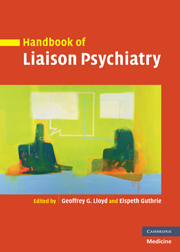Book contents
- Frontmatter
- Contents
- List of contributors
- Preface
- Part I Basic skills
- Part II Common psychiatric problems across the general hospital
- 7 Functional somatic syndromes
- 8 Alcohol problems in the general hospital
- 9 Drug misuse in medical patients
- 10 Sexual problems in medical patients
- 11 Suicide and deliberate self-harm
- 12 Delirium
- 13 Childhood experiences
- Part III Working with specific units
- Part IV Treatment
- Part V Different treatment settings
- Index
- References
10 - Sexual problems in medical patients
from Part II - Common psychiatric problems across the general hospital
Published online by Cambridge University Press: 10 December 2009
- Frontmatter
- Contents
- List of contributors
- Preface
- Part I Basic skills
- Part II Common psychiatric problems across the general hospital
- 7 Functional somatic syndromes
- 8 Alcohol problems in the general hospital
- 9 Drug misuse in medical patients
- 10 Sexual problems in medical patients
- 11 Suicide and deliberate self-harm
- 12 Delirium
- 13 Childhood experiences
- Part III Working with specific units
- Part IV Treatment
- Part V Different treatment settings
- Index
- References
Summary
Introduction
Sexual dysfunction is a common consequence of medical illness and should be considered in any medical patient undergoing a psychological assessment. Even though sexual problems can be among the most demoralizing and disabling features of medical disorders, they are frequently overlooked or neglected by clinicians. Furthermore, there is uncertainty about how sexual problems should be defined, particularly in women. In order to make a complete assessment of sexual difficulties the clinician must have a working knowledge of the anatomy, physiology and psychology of sexual function. As in all areas of liaison psychiatry, psychiatrists can only assess the role of psychological factors if they are knowledgeable about the presenting medical problem.
The anatomy and physiology of sex
The penis is composed of two functional compartments, the dorsal, paired corpora cavernosa and the ventral, corpus spongiosum, surrounded by the tunica albuginea. The corpora cavernosa are complex structures composed of smooth muscle fibres, neurones, endothelial-lined vascular spaces, coiled arteries and arterioles. The blood supply arises from the paired cavernosal arteries, which are terminal branches of the internal pudendal artery. Branches of the cavernosal artery, the helicine arteries, open directly into the cavernosal spaces. Blood drains into post-cavernosal venules to reach larger veins that pass through the tunica albuginea and connect with the deep dorsal vein. Blood is retained in the penis during erection by passive compression of the cavernosal venules against the tunica albuginea. Innervation is by somatic and autonomic nervous systems.
Keywords
- Type
- Chapter
- Information
- Handbook of Liaison Psychiatry , pp. 221 - 244Publisher: Cambridge University PressPrint publication year: 2007



